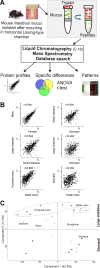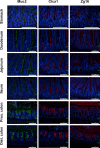Studies of mucus in mouse stomach, small intestine, and colon. II. Gastrointestinal mucus proteome reveals Muc2 and Muc5ac accompanied by a set of core proteins
- PMID: 23832517
- PMCID: PMC3761249
- DOI: 10.1152/ajpgi.00047.2013
Studies of mucus in mouse stomach, small intestine, and colon. II. Gastrointestinal mucus proteome reveals Muc2 and Muc5ac accompanied by a set of core proteins
Abstract
The mucus that protects the surface of the gastrointestinal tract is rich in specialized O-glycoproteins called mucins, but little is known about other mucus proteins or their variability along the gastrointestinal tract. To ensure that only mucus was analyzed, we combined collection from explant tissues mounted in perfusion chambers, liquid sample preparation, single-shot mass spectrometry, and specific bioinformatics tools, to characterize the proteome of the murine mucus from stomach to distal colon. With our approach, we identified ∼1,300 proteins in the mucus. We found no differences in the protein composition or abundance between sexes, but there were clear differences in mucus along the tract. Noticeably, mucus from duodenum showed similarities to the stomach, probably reflecting the normal distal transport. Qualitatively, there were, however, fewer differences than might had been anticipated, suggesting a relatively stable core proteome (∼80% of the total proteins identified). Quantitatively, we found significant differences (∼40% of the proteins) that could reflect mucus specialization throughout the gastrointestinal tract. Hierarchical clustering pinpointed a number of such proteins that correlated with Muc2 (e.g., Clca1, Zg16, Klk1). This study provides a deeper knowledge of the gastrointestinal mucus proteome that will be important in further understanding this poorly studied mucosal protection system.
Keywords: Muc2; Muc5ac; mass spectrometry; mucin; proteomics.
Figures





References
-
- Andersch-Björkman Y, Thomsson KA, Holmén Larsson JM, Ekerhovd E, Hansson GC. Large-scale identification of proteins, mucins and their O-glycosylation in the endocervical mucus during the menstrual cycle. Mol Cell Proteomics 6: 708–716, 2007. - PubMed
-
- Atuma C, Strugula V, Allen A, Holm L. The adherent gastrointestinal mucus gel layer: thickness and physical state in vivo. Am J Physiol Gastrointest Liver Physiol 280: G922–G929, 2001. - PubMed
Publication types
MeSH terms
Substances
Grants and funding
LinkOut - more resources
Full Text Sources
Other Literature Sources
Molecular Biology Databases
Miscellaneous

